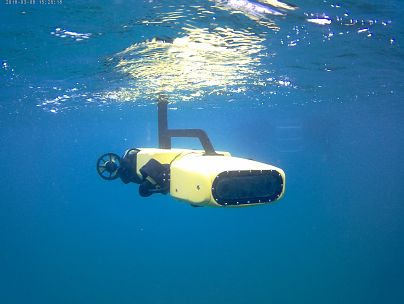RangerBot can identify coral-eating starfish and inject them with deadly poison.
It's a killer robot with a good heart. After years of development and testing, researchers in Australia are preparing to launch an autonomous underwater drone designed to help safeguard the Great Barrier Reef — a mission that includes neutralizing with a lethal injection a coral-eating species of starfish that threatens the reef's health.
Dubbed RangerBot, the briefcase-sized robot has a vision system that lets it navigate underwater, avoid obstacles and identify crown-of-thorns starfish. These creatures, which are covered in venomous spines and can grow almost to the size of a manhole cover, can "devastate large tracts of reef," said Matthew Dunbabin, an engineering and robotics professor at Queensland University of Technology in Brisbane, Australia, and one of the researchers who built the bot.
Dunbabin said the robot, which uses thrusters to move around, is able to identify its quarry with 99.4 percent accuracy. "Once the identification is confirmed, RangerBot can instigate an injection which is fatal for the crown-of-thorns starfish but doesn't affect anything else on the reef," he said in a statement.
But crown-of-thorns starfish are just one threat facing the world's largest coral reef, which stretches more than 1,400 miles off Australia's northeastern coast. Water pollution and overfishing are stressing the reef, and warming ocean temperatures are starving the coral of the algae on which it feeds. That can cause bleaching, which gives the coral a ghostly pallor and makes it more likely to die.
In 2016, huge swaths of the reef experienced a "mass bleaching" event, and some scientists feared the once-vibrant ecosystem was on the brink of collapse. Recent research shows the reef is recovering, but it remains vulnerable.
In addition to killing pesky starfish, RangerBot is designed to help monitor the reef's health by creating 3D maps that can reveal changes in the ecosystem, Dunbabin told NBC News MACH in an email. The drone can stay down much longer than divers can and venture into places too dangerous for humans, such as shark- or crocodile-infested waters.
"Having people in the field is always a liability," said John Bruno, a University of North Carolina marine biologist who isn't involved with the project. "This could really simplify things — there's less training, you can take a smaller ship to get out to the sites, you don't have to feed it. I can see a lot of benefits."
Bruno added that the RangerBot or similar robots could be used to monitor reefs around the world, including ones that are less well-studied than the Great Barrier Reef.
"There's so much money that goes into monitoring that reef already, and we know more about it than anywhere in the world," he said. "But there are lots of reefs that haven't been surveyed, and we don't know the effect that the 2016 bleaching has had on them."
Dunbabin is working with the Great Barrier Reef Marine Park Authority and the Australian Institute of Marine Science to obtain the necessary approvals for RangerBot to begin its patrols.












